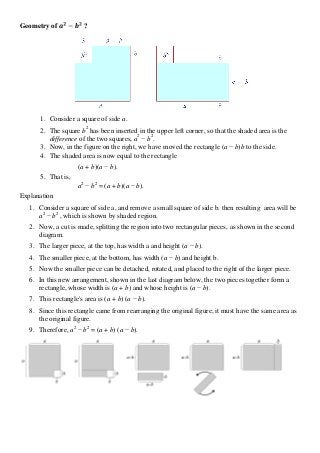
Geometry of a^2 b^2
- 1. Geometry of ? 1. Consider a square of side a. 2. The square b2 has been inserted in the upper left corner, so that the shaded area is the difference of the two squares, a2 − b2. 3. Now, in the figure on the right, we have moved the rectangle (a − b)b to the side. 4. The shaded area is now equal to the rectangle (a + b)(a − b). 5. That is, a2 − b2 = (a + b)(a − b). Explanation 1. Consider a square of side a, and remove a small square of side b. then resulting area will be a2 − b2 , which is shown by shaded region. 2. Now, a cut is made, splitting the region into two rectangular pieces, as shown in the second diagram. 3. The larger piece, at the top, has width a and height (a − b). 4. The smaller piece, at the bottom, has width (a − b) and height b. 5. Now the smaller piece can be detached, rotated, and placed to the right of the larger piece. 6. In this new arrangement, shown in the last diagram below, the two pieces together form a rectangle, whose width is (a + b) and whose height is (a − b). 7. This rectangle's area is (a + b) (a − b). 8. Since this rectangle came from rearranging the original figure, it must have the same area as the original figure. 9. Therefore, a2 − b2 = (a + b) (a − b).
